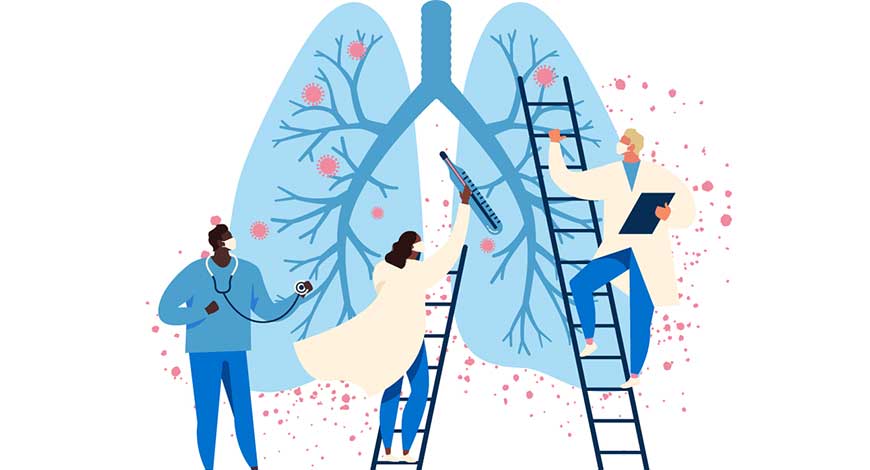COVID-19
Laboratories stocks fall as COVID-19 outbreak eases

Diagnostic companies in India are anticipating that demand for testing will plummet in 2022.
The Indian Council of Medical Research (ICMR) had approved 1844 private and 1411 government laboratories to conduct Covid-19 tests. Of these, only 2141 (764 government and 1377 private) labs conducted the RT-PCR tests, and the remaining 1114 (647 government and 467 private) labs offered RAT, TrueNAT, CBNAAT, and other tests. It is estimated that a total of 74 crore Covid-19 tests were conducted in the past two years. How many of these tests were conducted by labs that had no proper approvals, authority, quality control, infrastructure, or qualified manpower is anybody’s guess.
There has been a manifold rise in self-testing, primarily in the urban areas. In the first 20 days of January 2022, 200,000 people reported results of their home-based Covid-19 self-tests to the ICMR, compared to just 3000 tests reported in the whole of 2021. This is notwithstanding that self-tests have a higher chance of missing an infection. This amounted to 0.6 percent of total 3.1 crore Covid-19 tests conducted.
ICMR reported that India conducted 3.1 crore Covid-19 tests between January 1 and January 20. This translates into self-tests contributing 0.6 percent to total tests conducted. However, manufacturers of the self-test kits maintain that the actual count of self-tests is likely to be several times higher. This also belies the reliability of India’s positivity rate. So far, seven kits have been approved for self-tests. And the combined production is of 1.2 crore kits per week. This is being scaled up for exports.
Having said that, diagnostic companies in India and overseas are anticipating that demand for testing will plummet in 2022. The stock market, a rational indicator of times to come, has already pronounced its judgment, if the recent tumble in Indian lab shares is anything to go by. The listed clinical laboratories are now looking for new sources of growth to fuel investor interest after seeing their massive coronavirus-fuelled stock rallies more than halved in recent months.
Technological advancements and emerging trends on Covid-19

Rajiv Nath
Forum Coordinator, AiMeD, and Managing Director,
Hindustan Syringes & Medical Device
 Subhash Vashisht
Subhash Vashisht
Senior Technical Advisor, Medical Electronics,
Association of Indian Medical Device Industry (AiMeD)
Covid-19 opened massive opportunities for healthcare sector in tele-consultation, AI-based diagnostics, and remote healthcare management. The healthcare sector has become more focused on innovation and technology over the past two years of change with 80 percent aiming to increase their investment in digital healthcare tools in the coming five years. The following trends emerged:
-
Online shopping and robot-assisted contactless deliveries.
-
Digital and contactless payments.
-
Remote working from home and virtual meetings enabled by virtual private networks (VPNs), voice over-internet protocols (VoIPs), cloud technology, work collaboration tools, and facial recognition technologies.
-
Distance learning with many educational institutions started offering courses online to ensure education was not disrupted.
-
Tele-health became an effective way to contain the spread of Covid-19 while still providing essential primary care.
-
Online entertainment human creativity has brought the party online with cloud raves, online streaming of concerts and a surge of online gaming traffic and OTT.
-
Supply chain 4.0 were disrupted globally, and some countries implemented different levels of export bans on Covid critical medical devices. Core technologies of the Fourth Industrial Revolution, such as Big Data, cloud computing, IoT and Blockchain are building a more resilient supply chain-management system.
-
3D printing has been deployed to mitigate shocks to the supply chain and export bans on personal protective equipment and IVD swabs.
-
Robotics and drones have been used to disinfect areas, and used to deliver food, medical devices, and vaccines.
-
Information and communications technology (ICT) trends rely on a stable, high-speed, and affordable internet and 5G has demonstrated its importance in remote monitoring and healthcare consultation and the next frontier.
The road ahead is full of opportunities. If within two years of Covid pandemic, India could ramp up rapidly with high-tech innovative quality medical devices with conducive policies to encourage growth, the Indian medical device industry can achieve much greater success and make India the second factory in the world for medical devices.
“The outlook for laboratory shares is muted,” said Kranthi Bathini, a strategist at Mumbai-based WealthMills Securities Pvt. Limited. “The companies now need to focus on growth from non-Covid streams. The businesses had appeared to increase by mergers and acquisitions, asserting offers when their shares had been at peak valuations.” Metropolis and Dr Lal each introduced acquisitions of smaller gamers last year, looking to move into new fields. API Holdings Ltd., which owns the healthcare brand PharmEasy, and has announced plans to go public, last year acquired a two-thirds stake in Thyrocare from its founders.
The selloff is similar to a global trend after surging healthcare spending and demand for Covid tests amid the pandemic led to multi-fold share-price gains for pathology firms all around the world. The US diagnostics industry, for instance, has seen a lot of ups and downs in the last two years. After seeing sluggish sales for Covid-19 tests during the summer, demand skyrocketed as the delta and omicron variants caused new surges in cases.
Quidel, while reporting its preliminary fourth-quarter revenue, beat analyst expectations on the back of rising demand for coronavirus tests that brought revenues up to around USD 635 million. While Covid-19 sales are down compared to the USD 678.7 million Quidel generated in the fourth quarter of 2020, the company hailed the past three months as its best ever from a volume perspective. However, the company in February is seeing demand moderate in the professional and retail markets, commensurate with lower Covid-19-positive cases. And test demand is expected to continue through the second quarter, bolstered by the continued fulfilment of state and US government orders… unless the government changes direction. The federal government has announced that it will purchase an additional 500 million rapid Covid-19 tests to distribute free to Americans, meant to meet the overwhelming demand for testing as the now-waning Omicron variant surged across the US. The procurement brings the administration’s total purchase to 1 billion at-home test kits. Quidel was awarded an order for 80 million units, 40 million for delivery in the first quarter and another 40 million kits in the second quarter.
Both Labcorp and Quest too are looking to the recovery of their respective base businesses in 2022 to offset the lost Covid-19 revenues. The lab giants are hoping the disruption the pandemic caused to routine testing and healthcare will subside.
Quest’s full-year 2022 guidance includes an expected overall revenue decline of 12 percent to 17 percent versus the prior year, while base business revenues are anticipated to increase approximately 3.5 percent to 6 percent.
The coronavirus pandemic, a driver for decentralization of hematology testing
 Mattias Isaksson
Mattias Isaksson
Senior Vice President, Marketing,
Boule Diagnostics
Regional strategies for laboratory diagnostics continuously swing between decentralized and centralized testing. One driver for centralized testing is efficient resource utilization, whereas a decentralized testing approach supports patient-centricity, with a shorter response time that enables earlier suggestion for diagnosis and initiation of treatment, or forms the basis for decisions on further testing.
With the current Covid-19 pandemic, the pendulum seems to be swinging in the direction of decentralized testing in many regions. Hematology analysis is maintaining its relevance in early disease investigations. The analysis is relatively cheap and, therefore, readily available, and the results providing the physician with information related to a wide range of health conditions, including anemia, hemostatic disorders, blood cancers, and infectious diseases. In some regions, a complete blood count (CBC) is recommended to be included in the triage strategy for SARS-CoV-2, and lymphocyte count has proven to provide valuable insights into disease severity. As a consequence, the interest in compact bench-top hematology analyzers for use in clinical settings outside of the central laboratory is increasing.
To offer value for installations at point of care, the analyzer needs to provide sufficient information to bring clinical insights, that is, reporting of laboratory-quality results of relevant parameters, preferably from a finger-stick sample to omit the need for phlebotomy expertise. The analyzer should also exhibit a robust and reliable performance, as these installations can be remote, and service can be at a far distance. Pre-analytics should not require manipulation of the patient sample, and system operations should be simple, with easy-to-understand workflows to minimize the risk of erroneous results.
Additionally, a beneficial cost per test justifies on-site testing as compared with sending samples away for analysis. Automated hematology analyzers, intended for use in a decentralized clinical setting, also need to be connected to bridge the gap between site for testing and location of centralized expertise. Digitization also contributes to ensuring patients getting similar care regardless of location and time.
Miniaturization of key technologies is one of the factors that have been driving the development of the point-of-care market. One enabler is the IT network infrastructure of healthcare providers, for which the coronavirus pandemic has urged further enhancements.
Labcorp’s CFO Eisenberg told investors that the company expects the strongest demand for coronavirus tests will be in the first quarter, with the trend clearly to be lower in the second half of the year, compared to the first half.
Neither Omicron nor the FDA emergency-use authorization were factored into Siemens Healthineers’ original revenue guidance. Siemens expects those two forces to contribute to strong demand for rapid antigen tests in Q2 2022, before sales may fall away during the summer months.
“Pricing has come down substantially for tenders in Germany. And considering we are not the only player to receive a US approval for its Covid-19 antigen test, we should see how pricing and volumes evolve over time in the United States,” CFO Jochen Schmitz said in a recent earnings call. “So, the overall market becomes more and more competitive. Therefore, we expect revenues to decline sharply in the second half.”
After closing a manufacturing facility over the summer, and laying off workers due to a lack of demand for tests, Abbott Laboratories reopened it in November 2021. CEO Robert Ford recently said at J.P. Morgan that the company had plenty of capacity. While the company reported its Q4 2021 sales of USD 11.5 billion, a 7.7-percent increase on an organic basis from a year ago, driven by a surge in demand for Covid-19 tests and gains in its base business, CEO Robert Ford warned that the testing market remains volatile and is going to be challenging to forecast in 2022. At the same time, the CEO said he does not expect coronavirus testing “to simply go to zero starting the second quarter” and “there’s potential for the upside of more Covid testing” for the remainder of 2022.
Abbott’s medical-device business continued to recover in the fourth quarter from the impact of the pandemic. Global medical-device sales increased about 16 percent on an organic basis in the period.
“Especially in the more hospital-based business, we saw a real nice trajectory of recovery in the beginning of Q4,” Ford said. “Q4 was looking like a continuation of that progression until probably December, where we saw a pretty big drop because of Omicron in most of our device businesses.”
J.P. Morgan analysts said in a note that Abbott’s earnings-per-share target of at least USD 4.70 comes in modestly below consensus of USD 4.75, despite having higher coronavirus testing revenues of USD 2.5 billion versus about USD 1 billion baked in.
All of the diagnostics companies face a challenge in forecasting future demand once cases start to go down from the latest peak. It is tempting to look at 2022 as a repeat of 2021, with the combination of lingering delta challenges, and Omicron taking the place of last year’s holiday surge.











